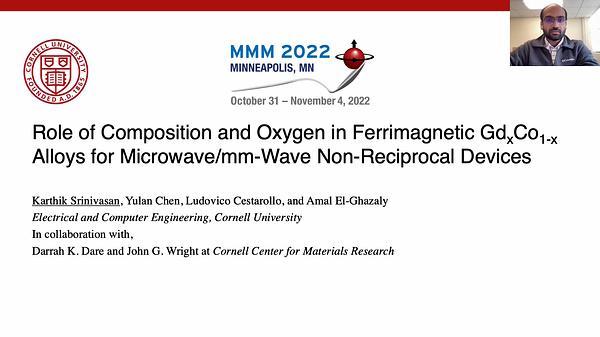Would you like to see your presentation here, made available to a global audience of researchers?
Add your own presentation or have us affordably record your next conference.
High-performance magneto-dielectrics with high permeability and permittivity, low magnetic and dielectric losses, and high cutoff frequency are promising candidate materials for next-generation communication applications, owing to their significant advantages for antenna miniaturization and bandwidth enhancement. Due to limited resonant frequencies and large natural resonance linewidths, conventional microwave ferrites and their composites, which are usually used over the frequency range from several hundred MHz to several GHz, do not meet the requirements for 5G communications.1-3 A unique type of hexaferrites named Mg-Zn 18H hexaferrite, whose crystal structure can be interpreted as the structure of Y-type hexaferrites with intercalation of a three-layered hexagonal barium titanate block into the middle of the T-block as shown in Fig. 1a, has been synthesized, and its microwave properties have been comprehensively investigated for the first time.4 The Mg-Zn 18H hexaferrite shows an extremely low damping coefficient of 0.1-0.2, indicating concentrated magnetic loss within a narrow frequency band and a narrow ferrimagnetic resonance linewidth of 486-660 Oe. Owing to this remarkably low damping coefficient, the Mg-Zn 18H hexaferrite possesses an excellent magnetic loss tangent as low as 0.06 and a small dielectric loss tangent less than 0.006 over 2-4 GHz, representing superior magneto-dielectric performance among the reported microwave ferrites for the S band applications as shown in Fig. 1b. Moreover, excellent thermal stability for the damping coefficient is observed to be 0.0004 K-1 over the temperature variation of most practical applications. When employed as the substrate of a 3.6-GHz patch antenna, the Mg-Zn 18H hexaferrite shows a miniaturization factor of ~5 and significant bandwidth improvement of ~50-110% over conventional dielectrics. These results imply the great technological potential and commercial value of the 18H hexaferrites for 5G communications.
References:
1V. G. Harris, IEEE Trans. Mag. 48, 1075 (2012).
2V. G. Harris, A. Geiler, Y. Chen, S. Yoon, M. Wu, A. Yang, Z. Chen, P. He, P. V. Parimi, X. Zuo, C. E. Patton, M. Abe, O. Acher, and C. Vittoria, J. Magn. Magn. Mater. 321, 2035 (2009).
3Q. Li, Y. Chen, C. Yu, K. Qian, V. G. Harris, J. Am. Ceram. Soc. 103, 5076 (2020).
4Q. Li, Y. Chen, C. Yu, L, Young, J. Spector, and V. G. Harris, Acta Mater. 231, 117854 (2022).

(a) Schematic illustration of the Mg 18H hexaferrite unit cell with the stacking subunit blocks denoted. (b) Performance of magneto-dielectric materials for microwave applications. The figure of merit (FOM) are indicated by the dashed lines.
